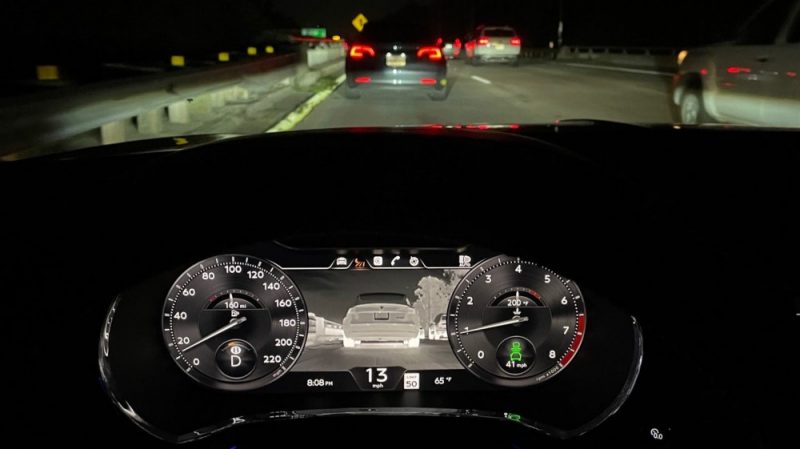The 2024 Bentley Continental GT’s thermal imaging camera is fascinatingly fun

A quick way to sum up the $350,000 Bentley Continental GT coupe is that it’s perception-warping. Sticker shock aside, it’s strange rolling around in something so big, luxurious, and supple, yet also has the ability to rip through a twisty road as capably as a sports car half its size. The Conti’s level of athleticism is not something you’d expect in something that weighs more than 5,000 lbs.
And yet, the warping doesn’t stop there. The new car market has made advanced driver assistance—like lane-keep assist and blind-spot monitoring—a commonplace for a few years. But recently, I experienced a whole other form of driver assistance offered in the Bentley Continental GT that I never had before: thermal imaging. And I found it truly fascinating.
This technology paints what we see in an entirely different light, and was fun to test while cruising around the streets of Los Angeles in peak opulence. Here’s how the British automaker’s thermal imaging system works, what it’s like to use, and how it could affect our concept of safety (for better or for worse).

Night Vision: A fitting proper noun
Bentley calls its thermal imaging system Night Vision, which is fitting since thermal imaging is common in some forms of conventional night vision systems. Fun coincidence: Bentley calls my test car’s silver color Moonbeam.
Thermal imaging is, simply put, a camera with sensors that pick up infrared light, or heat, from the electromagnetic spectrum and turn it into an image. On the flipside, conventional cameras and the human eye create images from visible light. It’s not entirely new, and has been in high-end luxury cars, but this was my first thorough interaction with the technology.
The image broadcasted on Bentley’s 12.3-inch instrument cluster is monochromatic—sorry, no room for Predator references here. The brighter the white light, the hotter it is. The camera is mounted behind the front grille and presents a 24-degree view of what’s ahead, all the way to 300 meters (984 feet), which is over a city block. The Conti isn’t the only Volkswagen Auto Group product with thermal imaging–it’s also offered on other Bentleys, high-end Audis, and the Lamborghini Urus SUV.
Since it’s thermal imaging, it doesn’t have to be nighttime to see what the camera’s picking up, and also goes a step further by highlighting pedestrians and cyclists that pass through its field of view. Though, the system didn’t pick up someone who wheeled past on a hoverboard scooter—which is either due to lacking a software update, or sharing its own opinion of such contraptions.
Wow, that’s a hot wall over there
As far as how it changed my perception, Night Vision did a number on the way I took in the world around me. It was cool to be behind a car with lots of bright light beneath it—indicating a hot exhaust system—but then change lanes and sit behind a Tesla that had barely any heat signature underneath it at all. Then, no matter the vehicle, it was cool to see traction at work in the form of brightly painted tires. It brought a new form of entertainment to sitting in excruciating traffic on California’s 110 freeway.
Another night, while on some local streets, I became fascinated with the most random things’ heat signatures. Different types of cars, houses, walls: It was a whole new world. While sitting at a stoplight in the neighborhood of Silver Lake, I said out loud, by myself, “Wow, that’s a hot wall over there.” The wall’s heat signature was significantly more pronounced than any other around it, possibly due to its color and the fact that it was facing west. Never thought I’d ever utter such a peculiar statement.
Then, while on a dark, desolate street in Beverly Hills where street lights were few and far between, the Bentley’s system highlighted a jogger far down the way who was nearly invisible to the naked eye, even with headlights illuminating the path ahead. Cool stuff for sure.
Truly helpful?
Despite my wonderment, I can’t help but wonder whether thermal imaging is truly helpful. There’s already a lot of tech in new cars that steals our gaze away from what lies ahead, like tapping screens to navigate through increasingly expansive infotainment systems. And because thermal imaging is so fascinating to use, you can’t help but look at it a bit longer than a quick glimpse to check your speed.
Still, it did come in handy: The fact that it highlights pedestrians and cyclists—which could be a quick glance down as opposed to a long stare—definitely makes up for its ability to be a gaze-stealer. And for anyone who parks one in their garage, the neatness would probably wear off after a while anyway. Even if they too happen to have a new-found curiosity for figuring out the reason behind random walls’ heat signatures.










